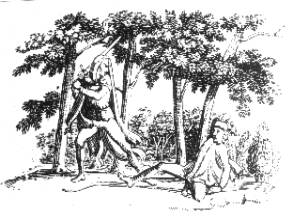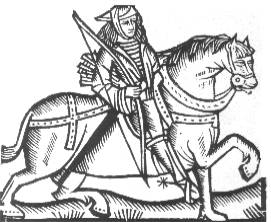The Legend 5
 In the Gest, Robin shoots the sheriff of Nottingham then beheads him. In Robin Hood and the Monk, Little John beheads a monk, then Much the Millar’s son does the same to the monk’s little page. The outlaws kill with vigor, and their ruthlessness cannot be overlooked, but Robin and his merry men were still seen as ‘good’ outlaws. In contrast, the Gest tells us that Robin is religious, he hears mass, is devoted to the Virgin Mary, and would never harm a woman. The sheriff’s wife, Sir Richard’s wife, and the prioress of Kirklees are the only women mentioned in the early ballads. There is no Maid Marian, even Sherwood Forest is not named in the Gest, and the only king mentioned was Edward. The sheriff of Nottingham and the prioress of Kirklees were never named, and as there were three King Edwards in succession, the author does not disclose in which century the Gest is set. Robin asks the knight if he was ‘made a knyght of force’, this refers to ‘distraint of knighthood’, which required military tenants who held twenty pound per annum to receive knighthoods or pay a compensation. This was enforced by Henry III, and continued by his son Edward I, and appears to be a reference to the thirteenth century. However, when ‘Edward our comly King’ comes to Nottingham in search of Robin and the knight, he later travels to Lancashire, and then to Plomton Park to inspect the state of his forests. Edward II is known to have inspected his forests in the fourteenth century, and he passed through Lancashire. Robin is associated with Barnsdale in Yorkshire, and with Sherwood Forest and Nottingham. The Yorkshire and Nottinghamshire components are especially evident in the Gest, which is thought to be made up of smaller ballads joined together to make an almost epic story.
In the Gest, Robin shoots the sheriff of Nottingham then beheads him. In Robin Hood and the Monk, Little John beheads a monk, then Much the Millar’s son does the same to the monk’s little page. The outlaws kill with vigor, and their ruthlessness cannot be overlooked, but Robin and his merry men were still seen as ‘good’ outlaws. In contrast, the Gest tells us that Robin is religious, he hears mass, is devoted to the Virgin Mary, and would never harm a woman. The sheriff’s wife, Sir Richard’s wife, and the prioress of Kirklees are the only women mentioned in the early ballads. There is no Maid Marian, even Sherwood Forest is not named in the Gest, and the only king mentioned was Edward. The sheriff of Nottingham and the prioress of Kirklees were never named, and as there were three King Edwards in succession, the author does not disclose in which century the Gest is set. Robin asks the knight if he was ‘made a knyght of force’, this refers to ‘distraint of knighthood’, which required military tenants who held twenty pound per annum to receive knighthoods or pay a compensation. This was enforced by Henry III, and continued by his son Edward I, and appears to be a reference to the thirteenth century. However, when ‘Edward our comly King’ comes to Nottingham in search of Robin and the knight, he later travels to Lancashire, and then to Plomton Park to inspect the state of his forests. Edward II is known to have inspected his forests in the fourteenth century, and he passed through Lancashire. Robin is associated with Barnsdale in Yorkshire, and with Sherwood Forest and Nottingham. The Yorkshire and Nottinghamshire components are especially evident in the Gest, which is thought to be made up of smaller ballads joined together to make an almost epic story.
Geoffrey Chaucer (1340-1400) described the knight’s yeoman in his prologue to The Canterbury Tales; this came close to Robin Hood:
| And he was clad in coat and hood of green |
| A sheaf of peacock feathers bright and keen |
| Under his belt he bore full thriftily |
| Well could he dress his tackle yeomanly |
| His arrows drooped not with feathers low |
| And in his hand he bore a mighty bow |
| Upon his arm he had a gay bracer |
| And by his side a gay dagger |
| Harnessed well and sharp as point of spear |
| A Christopher upon his breast of silver sheen |
| A horn he bare his baldric was of green |
| A forester was he truly I guess |
The Legend contains information found in Robin Hood, Holt, 1982; Rymes of Robyn Hood, Dobson and Taylor, 1976; Robin Hood: The Man Behind the Myth, Phillips and Keatman, 1995.

|
